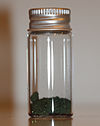
| |||
| |||
| Names | |||
|---|---|---|---|
| IUPAC name
4-[(4-Aminophenyl)-(4-imino-1-cyclohexa-2,5-dienylidene)methyl]aniline hydrochloride
| |||
| Identifiers | |||
3D model (JSmol)
|
|||
| ChEBI | |||
| ChEMBL | |||
| ChemSpider | |||
| ECHA InfoCard | 100.010.173 | ||
| EC Number |
| ||
| KEGG | |||
PubChem CID
|
|||
| RTECS number |
| ||
| UNII | |||
CompTox Dashboard (EPA)
|
|||
| |||
| |||
| Properties | |||
| C20H19N3·HCl | |||
| Molar mass | 337.86 g/mol (hydrochloride) | ||
| Appearance | Dark green powder | ||
| Melting point | 200 °C (392 °F; 473 K) | ||
| 2650 mg/L (25 °C (77 °F)) | |||
| log P | 2.920 | ||
| Vapor pressure | 7.49×10−10 mmHg (25 °C) | ||
Henry's law
constant (kH) |
2.28×10−15 atm⋅m3/mole (25 °C) | ||
Atmospheric OH rate constant
|
4.75×10−10 cm3/molecule⋅sec (25 °C) | ||
| Hazards | |||
| Occupational safety and health (OHS/OSH): | |||
Main hazards
|
Ingestion, inhalation, skin and eye contact, combustible at high temperature, slightly explosive around open flames and sparks. | ||
| NFPA 704 (fire diamond) | |||
Except where otherwise noted, data are given for materials in their standard state (at 25 °C [77 °F], 100 kPa).
| |||
Fuchsine (sometimes spelled fuchsin) or rosaniline hydrochloride is a magenta dye with chemical formula C20H19N3·HCl.[1][2] There are other similar chemical formulations of products sold as fuchsine, and several dozen other synonyms of this molecule.[1]
It becomes magenta when dissolved in water; as a solid, it forms dark green crystals. As well as dying textiles, fuchsine is used to stain bacteria and sometimes as a disinfectant. In the literature of biological stains the name of this dye is frequently misspelled, with omission of the terminal -e, which indicates an amine.[3] American and English dictionaries (Webster's, Oxford, Chambers, etc.) give the correct spelling, which is also used in the literature of industrial dyeing.[4] It is well established that production of fuchsine results in development of bladder cancers by production workers. Production of magenta is listed as a circumstance known to result in cancer.[5]
- ^ a b "Basic chemical data". Discovery Series online database, Developmental Therapeutics Program, U.S. National Institutes of Health. Retrieved on 2007-10-08.
- ^ Goyal, S.K. "Use of rosaniline hydrochloride dye for atmospheric SO2 determination and method sensitivity analysis". Journal of Environmental Monitoring, 3, 666–670, doi:10.1039/b106209n. Retrieved on 2007-10-08.
- ^ Baker JR (1958) Principles of Biological Microtechnique. London: Methuen.
- ^ Hunger K (2003) Industrial Dyes. Chemistry, Properties, Applications. Weinheim: wiley-VHC.
- ^ MAGENTA AND MAGENTA PRODUCTION (PDF). IARC MONOGRAPHS ON THE EVALUATION OF CARCINOGENIC RISKS TO HUMANS. Vol. 99. International Agency for Research on Cancer, World Health Organization. 2010. pp. 297 to 324. Retrieved January 12, 2013.
Magenta production is carcinogenic to humans (Group 1).


